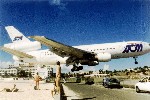St. Maarten Introduce 10-year Tourism Master Plan
 In a bid to improve its tourism industry the Government of St. Maarten has commissioned an international team of tourism consultants from Europe and the Caribbean to conduct an integrated study of all industry sectors to develop a 10-year Tourism Master Plan.Through an extensive public relations and tourism awareness campaign, the public was kept informed of all developments surrounding the “TourMap” as the Tourism Master Plan was dubbed.
In a bid to improve its tourism industry the Government of St. Maarten has commissioned an international team of tourism consultants from Europe and the Caribbean to conduct an integrated study of all industry sectors to develop a 10-year Tourism Master Plan.Through an extensive public relations and tourism awareness campaign, the public was kept informed of all developments surrounding the “TourMap” as the Tourism Master Plan was dubbed.
The TourMap team visited schools, community councils, the elderly, business organizations, etc. to get feedback from the general population during each stage of the plan. These groups were also invited to attend TourMap workshops; some tourism stakeholders participated in surveys, one-on-one interview and forums.
Key recommendations from the master plan address the following major tourism sectors:
Stay-over Tourism The study reveals that stay-over tourists on average spend just over US$140 per day compared to US$95 per day for a cruise visitor. An increase in stay-over visitors can significantly contribute to tourism revenue, thus support other sectors and improve local living standards.
On Dutch St. Maarten, there are currently 15 new properties in the pipeline to provide 1,942 new guest rooms. It is projected that guest accommodation capacity in 2010, based on the current stock of 3,500 rooms, will increase by 83% to the conservative estimate of 7,700 rooms.
ADVERTISEMENT
Key strategy recommendations include:
Controlled development of large-scale accommodation in short/medium term. For the next
3-4 years, renovation and upgrades of existing properties on the western part of the island; new accommodations in the Philipsburg area will be encouraged.
Aggressive campaign to mitigate seasonality-create reasons to visit (sporting,
entertainment, business), niche experiences, safety, good value.
Develop Mullet Bay Golf & Country Club.
Cruise Tourism St. Maarten experienced rapid growth since 2001 with the opening of the new pier and cruise terminal. Cruising is one of the fastest growing segments of leisure travel from North America and the fastest to recover from the impacts of hurricanes and 9/11. However, the tiny island is challenged to manage the high volume of visitors over a relatively short time, usually no more than 8-10 hours ashore. To ensure positive cruise travel, strategic recommendations include:
Cap peak days at the current maximum of 6 ships in order to optimize value and alleviate negative impacts.
Build cruise ship calls throughout week.
Expand range of attractions to better distribute passengers.
Ensure shopping continues to be relevant to the market-ensure that the range of shopping possibilities satisfies the changing profile and behaviour of visitors.
A conservative growth scenario, based on one additional large ship visit per week during peak season only, plus an average growth of +4% per year over the next five years and +3% per year between 2010 and 2015 would yield 43% growth in 2015.
Yachting/Marine Tourism St. Maarten is now an established service hub for the yachting sector, especially as a homeport during the season and the success of the annual
Heineken Regatta. Strategic strengths include location; berthing facilities; range, quality and cost of technical supplies and services; ease of accessibility by air; and range of support
services. Strategic recommendations for this sector include:
Provide incentives for development of facilities and services; skilled labour, environmental management.
Exploit synergies with condos/villas.
Promote tourism experiences to this sector of visitors.
Rebuild bare boat charter fleet.
St. Maarten will develop tourism programs to increase local employment to more than 2,800 jobs by 2010 that include create educational and apprenticeship programs and career advancements.
“Our plan is customer-focused, resident-focused, research-based and built to work all island sectors over time,” said Commissioner of Tourism Theo Heyliger. Despite a strong start to the
tourism season this year, Heyliger stressed the importance of maintaining socio-economic balance.
“We need to provide vacation experiences that visitors want, yet enhance the quality of life
for residents and preserve the natural environment. St. Maarten is only 37 square miles, so our resources are finite and we need to protect and ensure our longevity for the future,” he added.
This road map to the future of St. Maarten includes all the major policies, which impact on
tourism:
macro-economic policies that enhance/detract from business.
immigration and labour policies.
natural environment, physical planning, waste management
traffic management
regulations and fiscal regimes operating in political and administrative systems.
education, vocational training, career development.
public health.
security and public order.
Since tourism is a major engine in economic development, there is need for the tourism industry and government to effectively shape and influence a wide range of issues surrounding these policies.
——-

